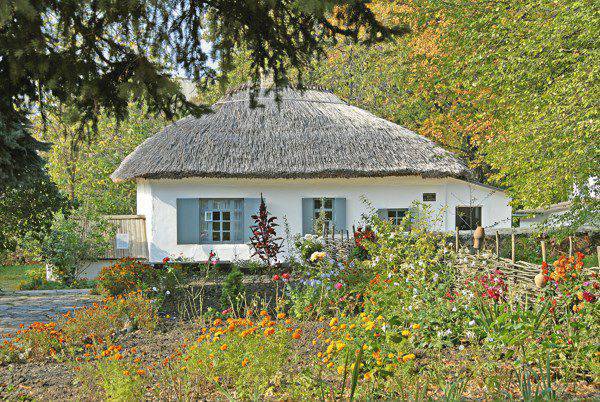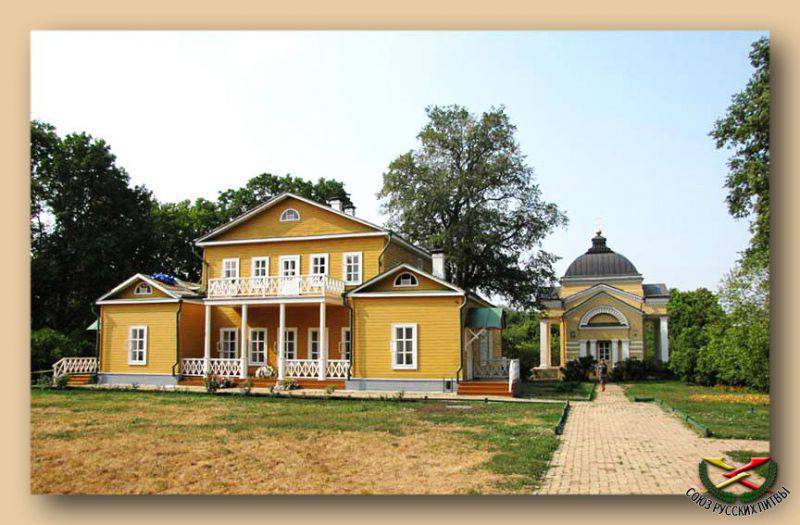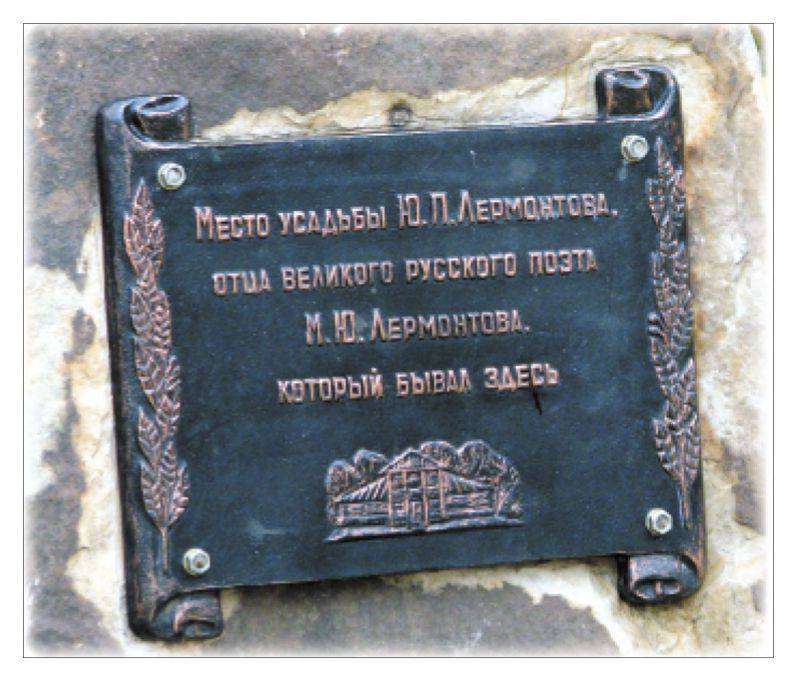The fate of the museums of Lermontov in the war years
Tarkhany
In the spring of 1941, the museum workers in Tarkhany (this is the Penza region) were preparing to hold large events related to the centenary anniversary of the death of Mikhail Yuryevich Lermontov. The museum was still young - only two years, but already famous, one might say, for the whole country. Every month he received a huge number of visitors. So, there was a thorough preparation. Correspondents from various newspapers had already arrived, were waiting for guests from the capital. Memorial evening was to be held in July. But, of course, canceled ...
Fascists, fortunately, did not reach Penza. But some parts of our retreating troops at that time marched through Tarkhany. And the museum worked. There are still guided tours. In the first year of the war, our soldiers had a tradition: those who went to the front from the Penza region, had to visit Tarkhany. In addition, in Penza, during the years of the Great Patriotic War, ninety hospitals were located, where about two hundred thousand wounded were treated. And the men, recovered, before the road, too, tried to visit the museum. It was a kind of inspiration: after all, Lermontov also fought.
In 1941 alone, about twelve thousand people visited the estate. Of these, more than ten thousand are soldiers. Many visitors were from among the evacuees. Indeed, in the first year of the war, about fifty industrial enterprises “moved” to Penza, including machine-building plants in Moscow, Leningrad, Orel, and Kursk. Artillery and mortar schools, a school of junior aviation personnel were located in Penza. Here was formed 10-I army, five rifle divisions, including the 354 Kalinkovichi division, which became famous for the fact that it never retreated in all four years.
How many people - and very many rushed to the museum. It is surprising: they found the same time, desire and strength! - and at the same time admires - the same.
But there were only six people on the staff of the museum! But they managed not only to receive visitors, but also to keep in order both the estate and the park zone (which is almost two hundred hectares!). The museum workers did not have the concept of “working day”: the tourists could come at any time of the day, they would have opened the door and showed everything. There was a case when our fighters passed through Tarkhany at night. They only wanted to ask for a night, but all the workers of Tarkhan got up and held a real excursion for the soldiers.
Here it is necessary to mention the guide - the girl Anya Shubenina. Her pedigree went back to Lermontov’s Lukerje fortress breadwinner, and Anya herself confessed that she had seen her second home in the estate. Perhaps that is why in the book reviews the war years are most often found thanks to the master-guide Shubenina.
The watchman of the chapel Andrei Efimovich Isaev, who received disability, participating in the Russian-Japanese war. He was born and raised in Tarkhany and knew about Lermontov not only from books, but also from folk legends. Visitors often took Andrei Yefimovich as a guide, and Irakli Andronikov, having become acquainted with a modest watchman, dedicated the story “Countryman of Lermontov” to him.
Ivan Vasilyevich Kuzmin also worked as a watchman, his duties did not include an eccursion. But he told about Lermontov in such a way that he appeared before the guests as a participant in those old events: now a close friend of his grandmother, Mikhail Yuryevich, then an advisor to the poet himself. At "Vasilich" fighters, as a rule, laughing, asked: "How old are you?".
Here is an entry from the book of reviews of those years: “During the war years I drove with me along the front roads a little book of the Demon. Lermontov became my best friend. And today, on the day of the visit to the museum, I say thank you ... Veronika Popova, a student at the Faculty of History of Moscow State University ... ”
Pyatigorsk

Before the 1943 of the year - the time of the onset of the fascist occupation - “Lermontov's House” in Pyatigorsk received visitors. Here, as in Tarkhany, in the summer of 1941, they also prepared events dedicated to the centenary of the poet’s death. And they also did not take place. However, guests were in a hurry to the museum - and also, mostly, soldiers.
But 1943 year has come. Pyatigorsk was occupied by the fascists. The museum workers closed the Lermontov House - they were not going to conduct excursions for the Germans. However, this did not happen. Then the museum staff quit, leaving the state only three people: those who had small children, they had to be fed.
The Nazis came to the "house" every day. They were looking for valuables, but they were hidden long before the occupation began. The director at that time was Elizaveta Ivanovna Yakovkina, she left a memory book. And in this book there are amazing lines about saving the museum ... by a policeman.
The fascists understood that our troops were about to come and the time of their power would end. And “The House of Lermontov” is a Russian shrine, the world-famous poet was born here. And the enemies decided to burn the museum.
10 January 1043, a drunk policeman with a convolution under his arm appeared in the museum (most likely it was an incendiary bottle). By that time, fires had already broken out throughout the city. And although the museum workers gathered around the “House” a large pile of snow, but this could not prevent the fire, but only help with it.
The policeman announced that he had the order to burn the museum. He was surrounded, they began to persuade him not to do it. But the thug was implacable. And here it is necessary to tell about one more person - Oleg Panteleimonovich Popov.
Before the occupation, Oleg Panteleimonovich also worked at the Lermontov House - a research assistant. In the very first days of the Great Patriotic War, he volunteered to go to the front, but he was not taken due to poor eyesight. And when the fascists entered Pyatigorsk, a policeman’s bandage appeared on Popov’s sleeve. Yes, he officially entered the service of the Nazis - this, unfortunately, is a fact. But, according to his contemporaries, compatriots, in fact, he had the task of helping citizens, including the museum staff. Oleg Panteleimonovich did not become a punisher. He warned people about impending arrests and round-ups, and they saved more than one life. At that time there were a lot of evacuated citizens of Leningrad in the Caucasus. Many of them went to the south, and fell into the occupation. The Germans were hunting for them. But almost all of Leningrad remained alive thanks to Popov, who stamped in their documents a stamp about permanent residence in Pyatigorsk.
But back in January 10, to the museum sentenced to be burned. It is not known where Popov came from and resolutely told the policeman that even in the morning the Nazis had mined the area around the museum. He did not believe it, but he was afraid to set fire to the “House”. And he led Popov to the authorities in order to find out if this was so. However, the clarification did not take place: at the last minute the policeman needed to leave, and Popov fled from the Gestapo. He hid an employee of the museum. And the next morning our troops entered Pyatigorsk.
A few years after the war, Popov, who was then working as a literature teacher, was arrested. As a traitor, he was sentenced to twenty years of correctional labor. However, later, ahead of time, Oleg Panteleimonovich was rehabilitated. He collaborated with the museum, his materials are in the famous "Lermontov Encyclopedia".
I will finish the story about the military fate of “Domik” with lines from the book of reviews that were written during the first days after the occupation: “We thought about this sacred place for all of us - the house where the poet lived, in the mountains, where our comrades fought with the Germans . And we are happy that the regiment of the Red Army liberated Pyatigorsk. We are happy that the Lermontov House has been preserved ... ”
Lipetsk region
And now we are transported to the Lipetsk region. It is also associated with the name of Mikhail Yuryevich Lermontov: on its very border there is the village of Kropotovo, where the patrimony of the father of the poet was located.
... Winter 1941 year. The Nazis occupied part of the Stanovlyansky district of the Lipetsk region. But the authorities did not hold back and now they were retreating under the pressure of our soldiers. Leaving the foreign land, the Germans burned everything they could for themselves. On their way lay the village of Kropotovo, in those years it was large, with beautiful wooden houses and an old manor. The Nazis did not spare the village, turned to ashes. Together with the houses, the historical monument of Russian culture, the estate of Yury Petrovich Lermontov, the father of the famous poet, burned to the ground. Only the old poplar alley, which was planted by little Misha, remained from the manor. Saved trees severe frost, did not let the fire inflame.
“Nothing, we will restore!” The stanovans said then. But immediately after the Great Patriotic War, they, like all the people of our large country, were seized by other concerns. It was necessary to rebuild houses, collective farms, raise industry and agriculture. So it was left ravaged by the place where once was the estate of Yuri Petrovich Lermontov. Only poplars stood as if they were waiting for someone ...
... 1961 year. Alla Matveevna Shatalova, the creator and leader of the Lipetsk 32 school drama club, was preparing a literary evening devoted to Mikhail Lermontov's 150 summer anniversary with her pupils. The production was worked out in detail, the last rehearsal is over. But the guys did not disperse, everything seemed to them that something else had not been completed. The boys and girls with leaving and talked, talked ... And it seemed that they got an idea by themselves: what if, on a vacation, to go to the Penza region, to visit the famous Tarkhans, where in the estate of Grandma Elizaveta Alekseevna Arsenyeva spent her childhood?
Alla Matveevna warmly supported the dream of the guys. But for its embodiment in life it was necessary to do very, very much. Most importantly, the students did not want to ask their parents for money for the trip, they decided to make money themselves. Therefore, for four long years, Alla Matveyevna’s pupils did not have holidays and weekends. They worked at the post office, in the labor teams, they set aside every penny they earned. It was precisely in those difficult days that the children understood that the love of the famous poet’s creativity turned them from pupils of one school into a Lermontov club. And as soon as this thought came to them, the name of the club was born - “Parus”.
... Summer 1966 of the year. Club "Parus" goes to Tarkhany. The guys have huge luggage with them: costumes, make-up, scenery. After all, for two whole years Lipchans were preparing a play that they dreamed of showing in Tarkhany. They did everything for the production themselves.
And in Tarkhany the disorder reigned. In those years, the house-museum of Mikhail Yuryevich Lermontov was not a state security zone. The house was in disrepair, it was impossible to enter it.
It seemed that clubbers should have dropped their hands. But on the first evening, the guys gathered the museum workers and residents of the neighboring villages and showed the performance. What started here! Literally every viewer invited them to their place to sleep. And the museum staff allowed the young Lermontov scholars to spend the whole summer in the estate. True, none of the Tarkhanovs did not think that the guys would not rest here, but work.
But the boys and girls began to work, sparing no effort. They cleaned the park, painted, dragged bricks, took out the garbage. We found a team of carpenters in Tarkhany who were ready to carry out a major overhaul. We entered into an agreement with them and gave the money left over from the trip. And back in Lipetsk, again forgot about the holidays and weekends. Klubovtsy wanted to fully pay for the work of carpenters.
Soon the guys wrote two letters to Moscow. One was addressed to the Minister of Culture Ekaterina Alekseevna Furtseva. They described in detail everything they saw in Tarkhany, asked to allocate money for the complete restoration of the estate and include the museum in the list of state protected zones. The second letter - with a request to move the state farm away from the museum - was sent to the Ministry of Agriculture.
Both requests were fulfilled! Since then, every summer klubovtsy spent in Tarkhany. But as owners, not guests.
... 1969 year. Now the guys went to Pyatigorsk, where the fateful duel of Lermontov and Martynov took place.
Here they were greeted warmly, but a little condescendingly. In the museum "House of Lermontov" at that time was the restoration work. Not to the guests! But the guys quickly proved that they are not idle guests. And they proved that this story is still told by the local residents of Pyatigorsk.
It is not known how boys and girls realized that the artist of the museum wanted to make a special coating of small colored granite on the walls. However, they decided to abandon the idea, because the stone needed about a hundred tons! Who can do such work?
And he was under the power of forty young Lipchans. For more than a month, boys and girls collected and crushed granite on the river Malka. And they did a job that adults considered impracticable.
... Spring 2007 of the year. Alla Matveevna Shatalova has already retired, the teacher of literature, Elena Mikhailovna Chilikina, has become the new head of Parus. Now there are other guys in the club, and another time in the yard. Only their love of Lermontov’s creativity remained unchanged. And she, this love, led the guys along a new road, now to Korotov, where the old poplar alley was still waiting for them ...
There was a lot of work here. Of course, from scratch to build a mansion did not make sense, because it is absolutely new, would not have become a house-museum. But the place itself needed to be put in order. In addition, the guys decided to install a memorial sign here. One of the first students of Parus, Tatiana Ivanovna Berbash, now a professional artist, volunteered to make it mock up.
And in the summer, the club went to Kropotovo to live here in a tent camp. The picture here appeared sad: nettle in human growth, wild raspberry. Alley and not see, it is hidden in dense thickets of shrubs. But it was not in vain that the guys brought shovels and axes with them - and it was a boil.
Almost all summer schoolchildren worked. Every evening, guys from neighboring villages also gathered at their bonfire. They read poems, sang songs. The boys from the village of Lukyanovka found and brought a large stone - just the kind that was needed for a memorial sign.
And here in the autumn in Kropotovo the grand opening of the old and at the same time new historical monument of Russian culture took place



Information